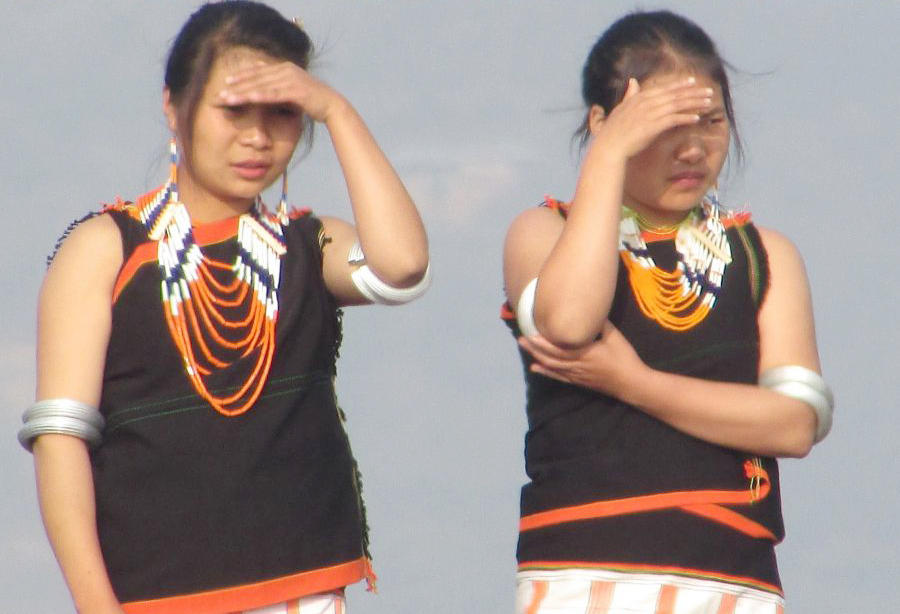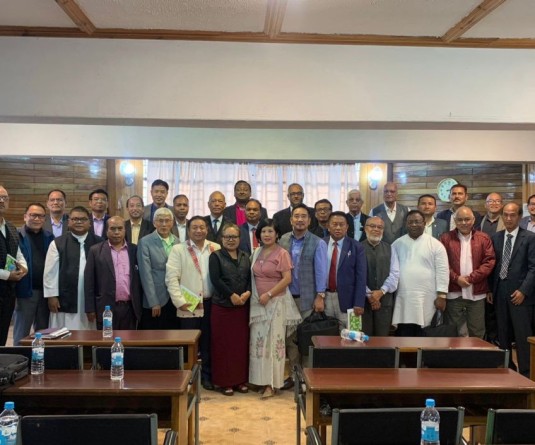Some important significance of Chakhesang Sühkrühnye festival

Men folk performing traditional act of Sühkrü rituals during Sühkrühnye premier festival. (Photo Courtesy: Kuzhovesa Soho)
Kuzhovesa Soho
Phek
Sühkrühnye is the most important festival of the Chakhesangs and is celebrated in the month of January. During this festival, boys and girls are sanctified through religious ceremonies and rituals. Sühkrühnye covers ten days.
The festivity period is preceded by a day known as ‘Thiza’. On this very day animals are killed and all necessary preparations for the rest of the festivity days are being prepared.
The first day is known as ‘Cedü’. The main activity of the festival starts on this day. The meat that are being killed one day ahead are being prepared, the new rice brew that has been prepared for the festival is also be opened on this day.
The second day is ‘Thupu Sühkrüh’, meant for men folk. ‘Sühkrüh’ signifies sanctification of young, innocent and unspoiled boys for this ritualistic ceremony. To perform this ceremony (Sühkrüh) everything to be made use of is new, including utensils and fireplace. The men folk go to the well early in the morning to take a freshwater bath immediately after the first crowing of the rooster in order to sanctify themselves. Thereafter, the unpolluted water, considered to be holy, is brought home. Then fire is made in the traditional fire-making method and unblemished rooster is killed and cooked with the holy water and eaten by the boy/boys to get sanctified for the rest of their lives. Even when a man constructs a new house, ‘Sühkrüh’ is performed in order to get his house sanctified.

On this day, the entire men folk go for community bird-trapping. The collected birds are hung on a decorated tip of a tall bamboo as a symbol of Sühkrühnye. Different kinds of birds so caught are believed to foretell the fortunes for the forthcoming days of the year for the individual concerned.
The third day is called ‘Thüno Nuso’ which is meant for women only. The mother performs this ceremonial ritual to sanctify her young innocent daughter/daughters. They prepare unblemished young hen and eat to sanctify themselves for their entire lives.
The fourth day is known as ‘Thunye Zadi/ Müthi Cehu’ where social feasts such as Mülehu or feast of social peer groups, etc. begin. In some villages Zhotho Muza (Feast of merit) also begins on this day. This day is free from religious restrictions.
The fifth day is known as ‘Cedü Zhongu’ which means accomplishment of the festivals.
The sixth is known as ‘Meve”. This day is set aside to do rituals to prevent occurrence of any natural calamities, especially fires.
Now that the festival’s religious pursuits are relaxed, they continue feasting, dancing and singing. Games are also performed throughout the day.
The other festive days that follow are called ‘Sühre Gada’ for two days. No regular works are done on these two days. The last day of the festival is called ‘Thunye Zho’. The day is kept holy in order to prepare for the rest of the year.
With the coming of Christianity, ‘Sühkrühnye’s religious and traditional ceremonies and rituals are no longer in practice in most of the villages. However, ‘Sühkrühnye’ is still celebrated with great significance and enthusiasm by the Chakhesangs in Phek district in keeping with Christian spirit.
Sühkrühnye is a time of joyful celebration and so people do anticipate and yearn for the next to come.
The Chakhesang Sühkrühnye Premier festival will all set to observe on 15th January where the stated rituals will perform with pomp and gaiety.




